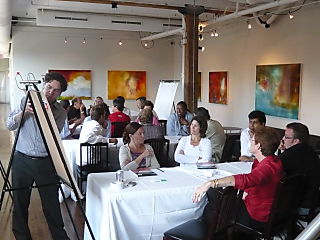I am closing down some of the open tabs, cleaning up draft versions and stuff I always wanted to blog about. Not all drafts stand the test of time, but some do. On the topic of good organization the report Digital company 2013: Freedom to collaborate written by Kim Thomas for the Economist Intelligence Unit stays interesting. Some of the key themes explored by the report are
- Technology knowledge will permeate the enterprise.
- Social networks will be common in the workplace, like it or not.
- Beware information paralysis.
- Digital tools will democratise access to information.
- Digital tools provide employees with greater control over the information they can access.
- IT will also need to loosen the reins.
- Ceding technology control will be good medicine.
And they note that in order to realise the benefits of improved collaboration business leaders must come to terms with autonomy: “for employees, in how they access information and spend their work time; and for business units, in what technologies they purchase and how they use them. Above all, it will require from executives a great deal of courage—to allow technology to bring customers and other third parties into the company’s operations—and trust in their employees to access and use information freely.”
In Auto industry and Enterprise 2.0 Andrew McAfee speculated what he would do if appointed “Detroit CIO”. While the set of 10 principles he’s applying is good, I am not too convinced that technology, i.e. rolling out emergent social software platforms (ESSPs) to all employees of the company, starting internal CXO blogs etc. would do the trick. The car industry is a heavy user of IT already, adding to the pile of tools won’t help in overcoming resistance. And that’s where the rub is: implementing Enterprise 2.0 concepts must cope with the people, processes and the tools they employ in these processes (I specifically doubt that Six Sigma or Lean Production processes can benefit much from Enterprise 2.0 concepts, these are repeatbale and highly automated processes, i.e. they don’t need no flexibility, adaptivity or emergence). But some other advanced (knowledge work) processes might benefit a lot – hey, collaboration and social software might even help in turning around a basically flawed business model, so Andrew’s thought experiment is very welcome.
Then, IBM Research is looking at adoption, usage patterns, motivations, and overall impact of Social Software in the Workplace (pdf). The paper focuses on the internal usage of social networking (Beehive) and examines the individual goals people have when utilizing these platforms (like interacting with colleagues, career advancement, convincing and informing others about ideas and projects).
Via Stewart I found Gerard Tellis & Ashish Sood‘s article “How to Back the Right Technology” in the Wall Street Journals and MIT Sloan’s Business Insight – dealing with mistakes organizations often make when choosing which technologies to adopt:
- They fail to distinguish among different levels of technology, with the result that they focus too much on one level and get tripped up by changes in another level.
- They assume technological performance follows a standard path — from innovation to obsolescence. It often doesn’t.
- They fail to recognize that technological innovations shape consumers’ tastes, not mere whims.
Good advice included, like e.g. try multiple things at once and don’t bet too heavily on one choice, on picking a winner:
- […] Technologies, and the competition among them, evolve in more-complex ways than conventional wisdom suggests. To make the right choices, managers need to understand these patterns of evolution.
- [so that] executives can avoid some common mistakes: missing a market-changing technological breakthrough, embracing a hot technology too eagerly or abandoning another one too quickly, and underestimating the effect of new technologies on consumers’ tastes.
And if you’re in doubt what technologies to evaluate for 2009 EDS’ Charlie Bess gives you something to think about, see his predictions for 2009 (granted, a mixed bag of IT technologies and/or approaches). To me, most important and most interesting is his starting point:
In this [financial et al. crisis] situation, the investments in technology can actually have more impact than at any other time, since your competitors may be in a purely cost cutting mode. In 2009 organizations must maintain a balance between the new/strategic and the immediate return, between operational cost-cutting and operational excellence. Anytime there is this level of conflict, the situation is ripe for innovation
Well, basically looks like a good situation for social software in the enterprise aka Enterprise 2.0 …


